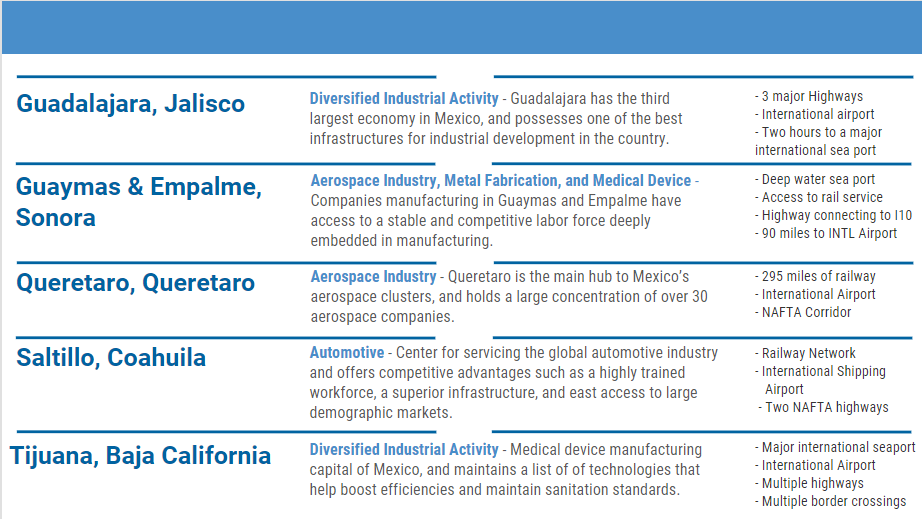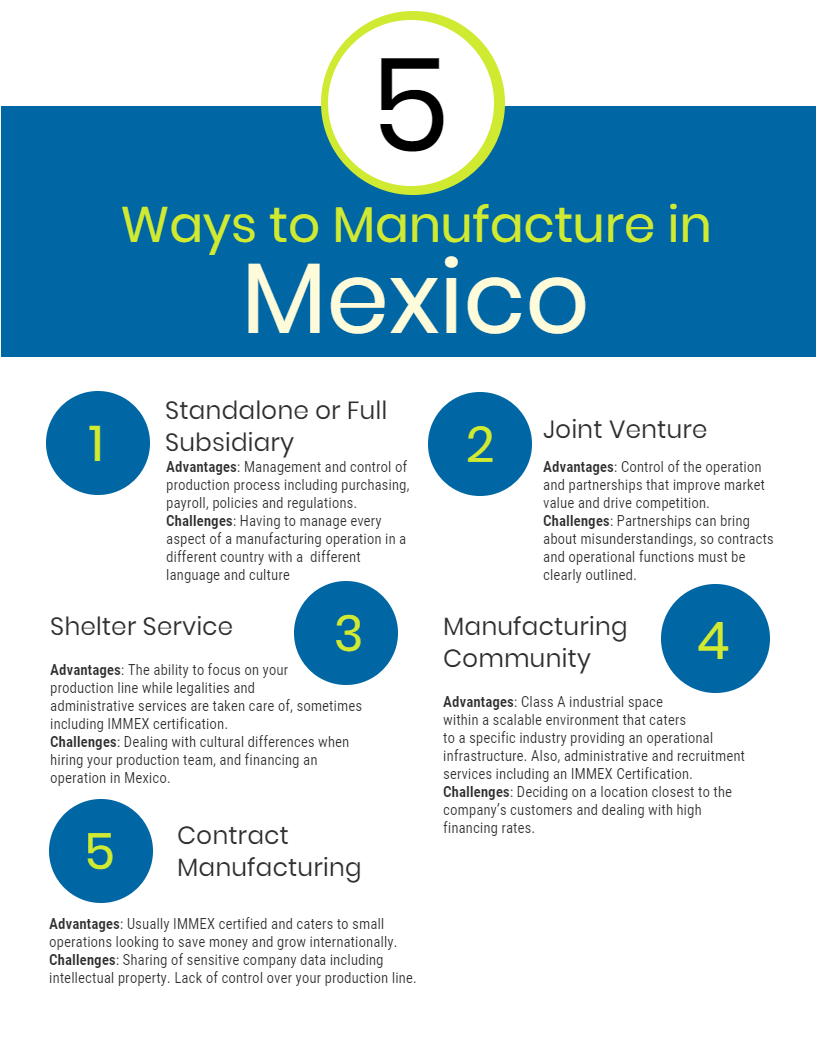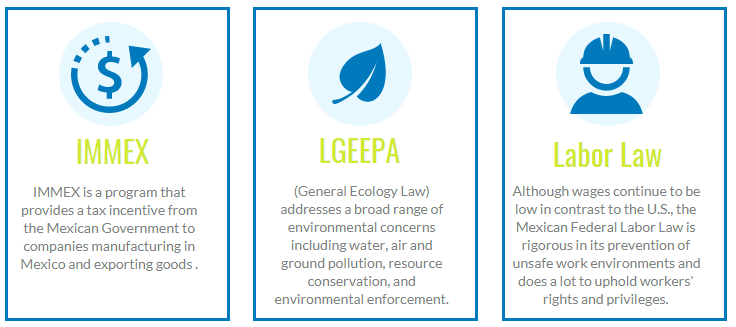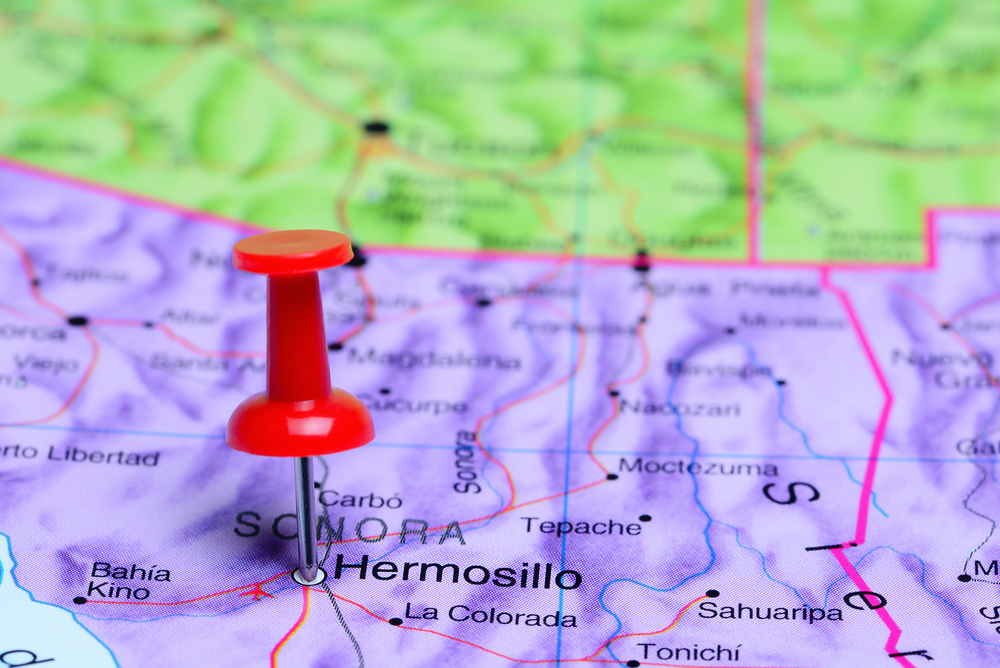Manufacturing in a new country comes with both advantages and challenges, being aware of both is the first step in managing an operation and watching it grow. Knowing where and how to land, and understanding your start-up costs is essential to maintaining an efficient production line south of the border. The next steps needed to launch, operate, and thrive in a successful facility should be done with precision.
First, Find Out Where You’re Going
Site selection might be the most important factor in enabling operational success in Mexico. High turnover rates, supply chain connections, and transportation logistics all play a factor in where the operation is located. Once a location has been selected, all other factors in the operation’s expansion usually fall into place.
The interior and border regions in Mexico are the most popular locations for industry production. Each region has their own industry cluster, and both have established resources, labor markets, and infrastructure to enable a smooth running operation. The locations include:

Or somewhere else! The Mexican manufacturing industry is a powerhouse, specifically in producing high skilled specialty goods such as aerospace, automotive, electronics, and medical devices. For over 50 years, Mexico has been cultivating the manufacturing culture and supporting a global market. A detailed plan targeting a location of your specific industry is important for deciding where to expand, whether it be for suppliers, customers, or logistical reasons.
Find Out How You’ll Start-Up
There are a few ways to start the production process, specifically when looking for real estate or a facility that will house a special operation. Stand-alone, Contract Manufacturing, Joint Venture, Shelter Service, and a Manufacturing Community are the main ways manufacturers decide to begin and operate. The decision to choose a specific mode of entry is based on the amount of control a company wants over their operation, and the size of the operation.

Figure Out Who You Need
The size of your operation is a factor in deciding where and how to manufacture in Mexico. Larger operations with more than 700 employees usually enter as a standalone or joint venture, but some have also used the other options. Small to medium sized operations that need from 699 to even 5 employees are usually best suited for contract manufacturers, shelter providers, and manufacturing communities.
Aside from deciding on the mode of entry, the number of employees needed can also dictate where you need to locate. Some regions have higher turnover rates than others, specifically the border cities. Competition for employees can be high along the border cities because of the dense population of manufacturing facilities and skilled workforce. Locating somewhere within the interior of Mexico provides a higher chance of workforce availability, with the possibility of lower wages. In both areas, the border and interior, employee training and orientation is suggested, and a growth program or process can support better attrition.
One other factor dealing with employees is how to manage expats working in Mexico. Employees from company headquarters who are chosen to move with the expansion need to follow certain immigration guidelines. They need to get a Temporary Residency with Permission to work visa, by applying and submitting supporting paperwork. Housing and utilities are also important to set up, along with the possibility of moving the family. Other living tips including bank accounts, health care, internet, and safety are also important considerations for foreign employees moving to Mexico.
Figure Out What Resources You Need
Much like expat employees, the operation needs a facility, utilities, infrastructure, and security. Many times companies look to consultants, Economic Development Corporations, shelter services providers, or manufacturing communities to help navigate their overhead needs.
Depending on the mode of entry, finding real estate and facilities for specific manufacturing processes can be time consuming. This also includes finding and installing utilities such as electricity, gas, water, telecommunications, internet, etc. Electricity comes from state branches of the CFE (Federal Electricity Commission), and is allocated and charged based on the average consumption of the type of operation within the region. Water and Gas are charged by consumption per cubic meter. When considering these overhead logistics, it is important to have a local or experienced guide help you navigate the best and most efficient services.
Find A Supply Chain Network
One other resource consideration is the location of industry suppliers or an industry supply chain network. Locating close to industry suppliers can lower inefficiencies, cut costs, and support environmental efforts. When a company is close to their suppliers, and their consumer market, transportation time to market is low which enables a boost in profits and lower logistics costs. For many companies entering the North and South American market, Mexico’s supply-chain cluster caters to various industries and has access to both American markets, with an infrastructure to facilitate the fast and safe transfer of products and goods.
Mexico’s proximity to the rest of North American, Central and South American markets positions it as a hub for all things that deal with trade throughout the connecting continents. Infrastructure along the goods transportation route has gone through recent reforms to provide better highway safety, easier access to international corridors, more rail infrastructure, and expansion for some major airports. Choosing a location with transportation infrastructure connected to your customer and suppliers is part of deciding where to land in Mexico.
The time it takes to transport, cross, and disperse goods is essential to deciding where to expand a manufacturing operation in Mexico. There are 27 border entries that allow trucks to cross to and from Mexico, 3 railroad lines, 7 sea ports with container line service, and more than 15 international cargo traffic airports. The main transportation highway corridors facilitate more than 500,000 inbound trips a year. Mexico’s access to global markets have enables manufacturers in Mexico to grow productivity no matter the size.

Get Certified and Become Regulatory Compliant
Mexico has manufacturing laws and policies that protect and cover customs, environment restrictions, occupational health and safety, goods and transportation security, labor, and taxes that enable a smooth process from the assembly line to the market. Some of the most important regulations to consider are IMMEX, LGEEPA, and Mexican Labor Laws.

Regulatory compliance also adds to the list of overhead items, and could prove to be very costly when certifications, forms, applications, and fees aren’t correct the first time around. There are also many one time startup fees spanning from tax forms and utilities, to licenses and certifications. Recognizing which fees are legally necessary will enable a smooth transition from startup to a fully functional operation. Enlisting in the help of a trusted guide can help you save time, money, and peace of mind.
Selecting the site of your Mexican manufacturing operation is key to guaranteeing sustainable success within the facility. Understanding your location’s supply chain resources, labor force, and regulatory stipulations is part of the journey to begin operations in Mexico. Once a company becomes more aware of the various tasks and considerations for expanding to Mexico, it can formulate a better analysis of the start-up costs, and create insight on the type of investment being made in Mexico.
Subscribe
Sign up and stay informed with tips, updates, and best practices for manufacturing in Mexico.







